Marketing in Practice Assessment: Spark New Zealand Case Study
VerifiedAdded on 2023/06/07
|18
|4057
|344
Report
AI Summary
This report provides a comprehensive analysis of Spark New Zealand's marketing practices, focusing on its telecommunications business in New Zealand. The report begins with an executive summary and an overview of the company, detailing its background, internal analysis using a SWOT framework, and strengths and weaknesses. It then proceeds to an external environmental scan, utilizing a PESTEL analysis to identify political, social, technological, and environmental factors influencing the company. The report further examines the impact of emerging technologies and digital marketing on the business, evaluating the influence of consumer-generated information. The report concludes by exploring segmentation and targeting strategies, including segmentation bases and target segment profiles. Overall, the report aims to provide insights into the business environment of the telecom sector and how Spark New Zealand can increase its competitive advantage in the market, based on data collected from various sources.
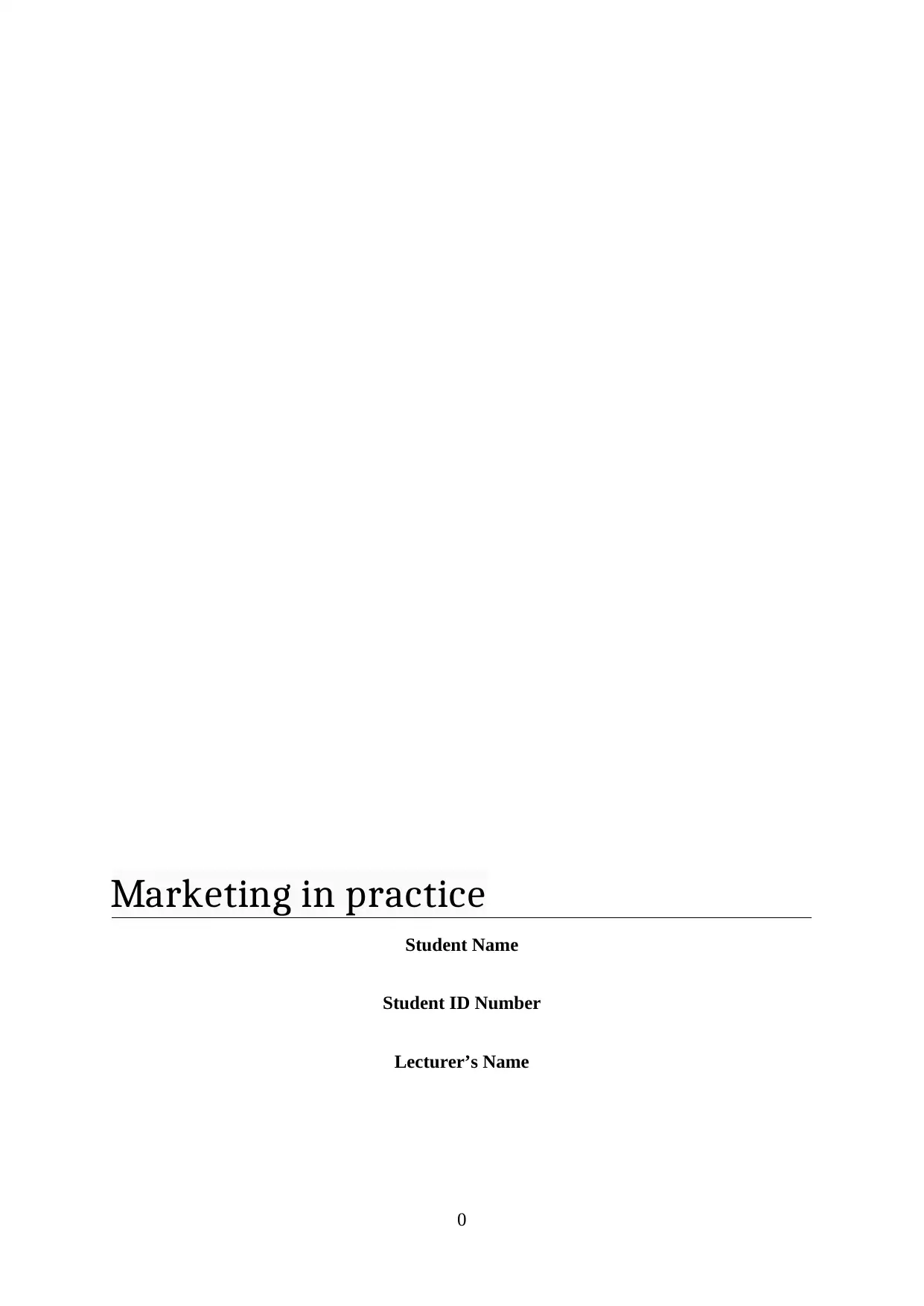
Marketing in practice
Student Name
Student ID Number
Lecturer’s Name
0
Student Name
Student ID Number
Lecturer’s Name
0
Paraphrase This Document
Need a fresh take? Get an instant paraphrase of this document with our AI Paraphraser
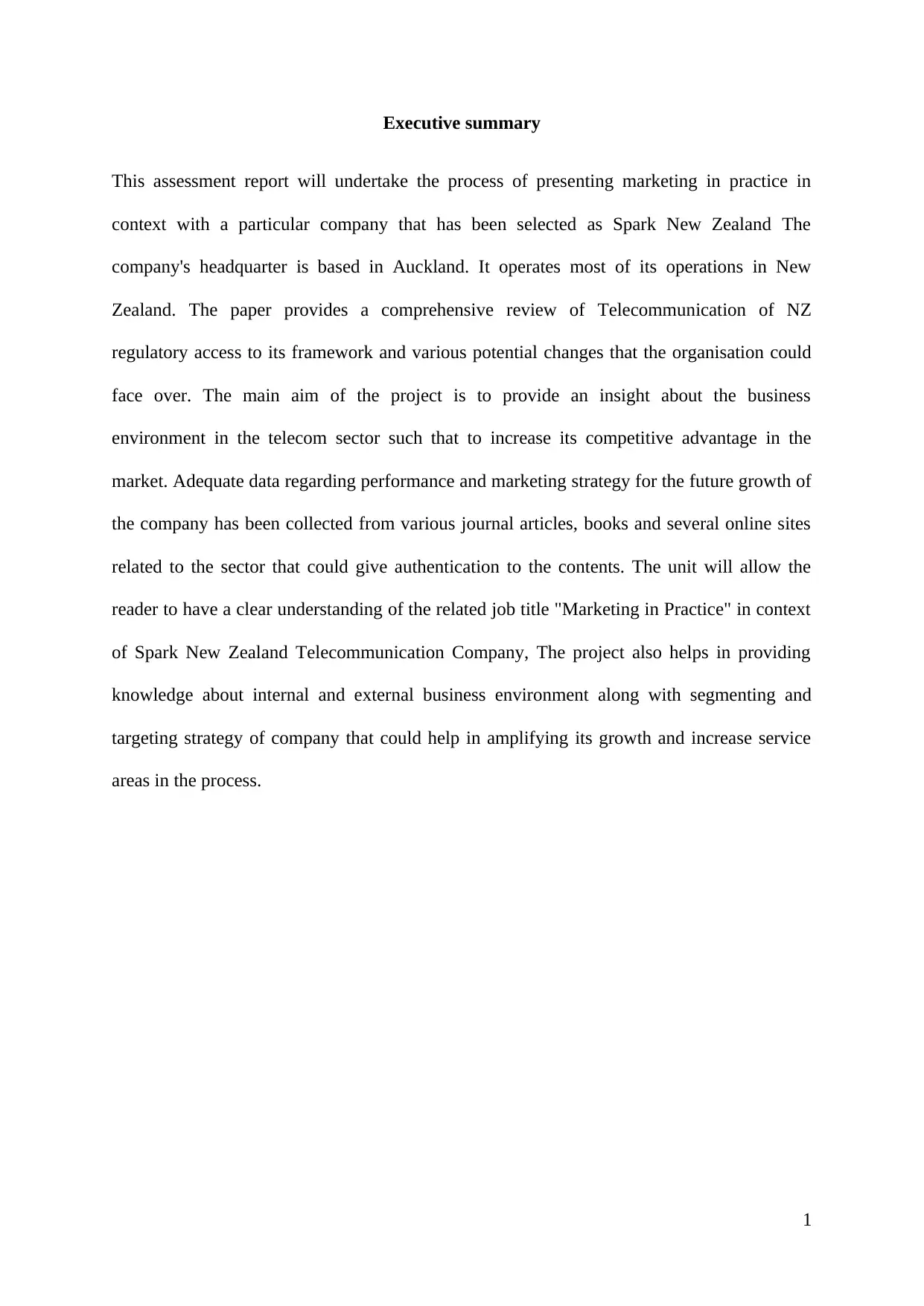
Executive summary
This assessment report will undertake the process of presenting marketing in practice in
context with a particular company that has been selected as Spark New Zealand The
company's headquarter is based in Auckland. It operates most of its operations in New
Zealand. The paper provides a comprehensive review of Telecommunication of NZ
regulatory access to its framework and various potential changes that the organisation could
face over. The main aim of the project is to provide an insight about the business
environment in the telecom sector such that to increase its competitive advantage in the
market. Adequate data regarding performance and marketing strategy for the future growth of
the company has been collected from various journal articles, books and several online sites
related to the sector that could give authentication to the contents. The unit will allow the
reader to have a clear understanding of the related job title "Marketing in Practice" in context
of Spark New Zealand Telecommunication Company, The project also helps in providing
knowledge about internal and external business environment along with segmenting and
targeting strategy of company that could help in amplifying its growth and increase service
areas in the process.
1
This assessment report will undertake the process of presenting marketing in practice in
context with a particular company that has been selected as Spark New Zealand The
company's headquarter is based in Auckland. It operates most of its operations in New
Zealand. The paper provides a comprehensive review of Telecommunication of NZ
regulatory access to its framework and various potential changes that the organisation could
face over. The main aim of the project is to provide an insight about the business
environment in the telecom sector such that to increase its competitive advantage in the
market. Adequate data regarding performance and marketing strategy for the future growth of
the company has been collected from various journal articles, books and several online sites
related to the sector that could give authentication to the contents. The unit will allow the
reader to have a clear understanding of the related job title "Marketing in Practice" in context
of Spark New Zealand Telecommunication Company, The project also helps in providing
knowledge about internal and external business environment along with segmenting and
targeting strategy of company that could help in amplifying its growth and increase service
areas in the process.
1
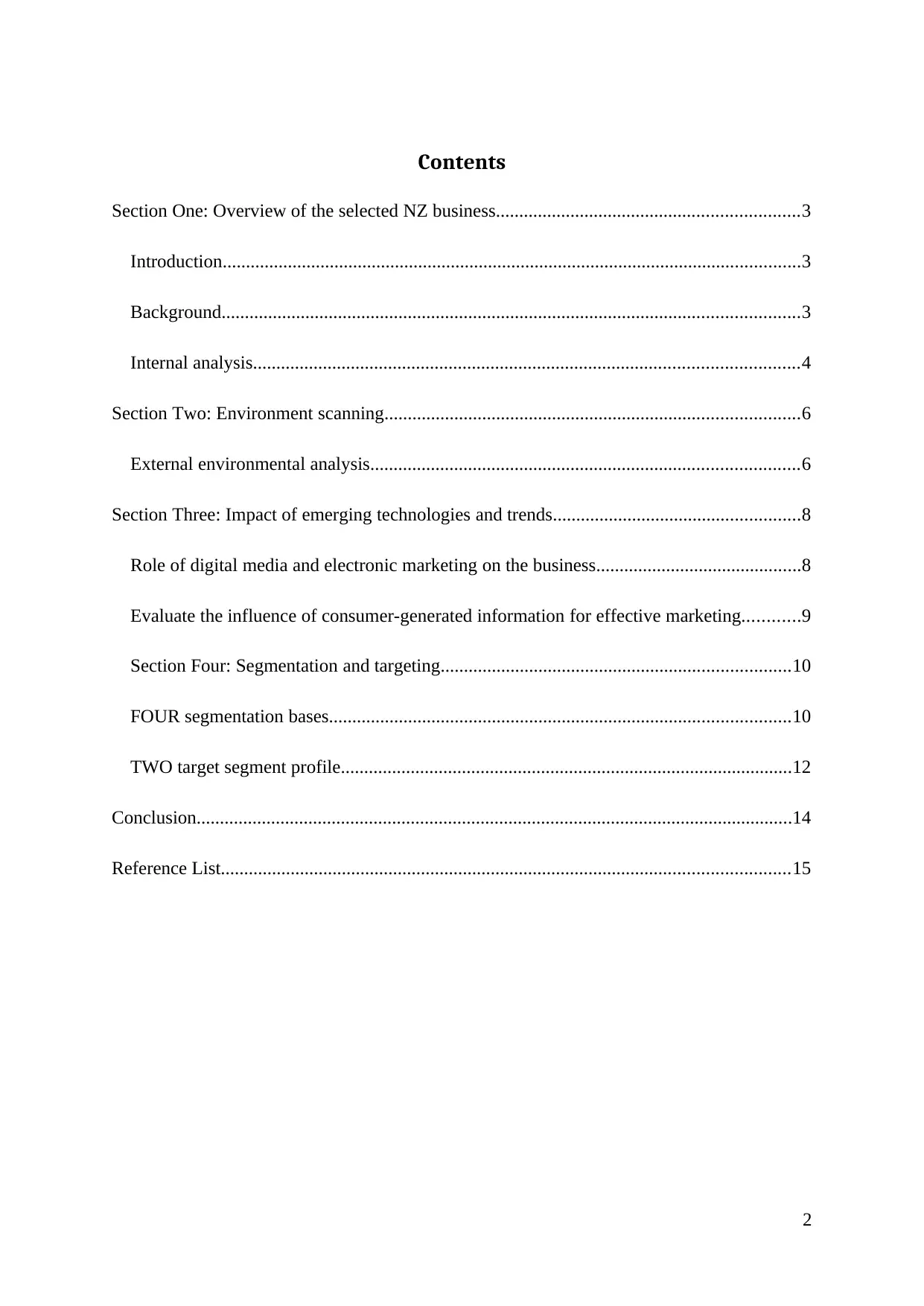
Contents
Section One: Overview of the selected NZ business.................................................................3
Introduction............................................................................................................................3
Background............................................................................................................................3
Internal analysis.....................................................................................................................4
Section Two: Environment scanning.........................................................................................6
External environmental analysis............................................................................................6
Section Three: Impact of emerging technologies and trends.....................................................8
Role of digital media and electronic marketing on the business............................................8
Evaluate the influence of consumer-generated information for effective marketing............9
Section Four: Segmentation and targeting...........................................................................10
FOUR segmentation bases...................................................................................................10
TWO target segment profile.................................................................................................12
Conclusion................................................................................................................................14
Reference List..........................................................................................................................15
2
Section One: Overview of the selected NZ business.................................................................3
Introduction............................................................................................................................3
Background............................................................................................................................3
Internal analysis.....................................................................................................................4
Section Two: Environment scanning.........................................................................................6
External environmental analysis............................................................................................6
Section Three: Impact of emerging technologies and trends.....................................................8
Role of digital media and electronic marketing on the business............................................8
Evaluate the influence of consumer-generated information for effective marketing............9
Section Four: Segmentation and targeting...........................................................................10
FOUR segmentation bases...................................................................................................10
TWO target segment profile.................................................................................................12
Conclusion................................................................................................................................14
Reference List..........................................................................................................................15
2
⊘ This is a preview!⊘
Do you want full access?
Subscribe today to unlock all pages.

Trusted by 1+ million students worldwide
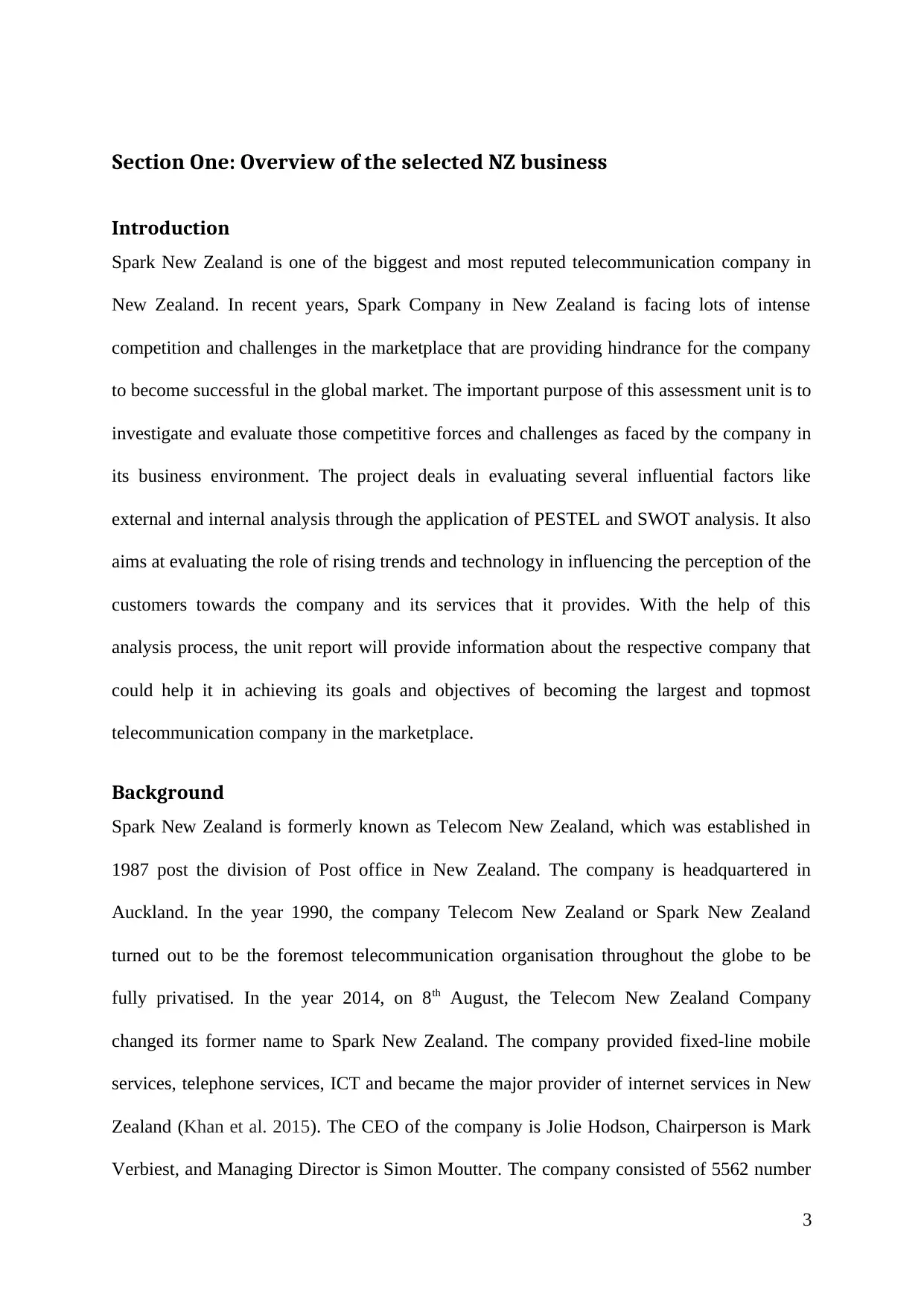
Section One: Overview of the selected NZ business
Introduction
Spark New Zealand is one of the biggest and most reputed telecommunication company in
New Zealand. In recent years, Spark Company in New Zealand is facing lots of intense
competition and challenges in the marketplace that are providing hindrance for the company
to become successful in the global market. The important purpose of this assessment unit is to
investigate and evaluate those competitive forces and challenges as faced by the company in
its business environment. The project deals in evaluating several influential factors like
external and internal analysis through the application of PESTEL and SWOT analysis. It also
aims at evaluating the role of rising trends and technology in influencing the perception of the
customers towards the company and its services that it provides. With the help of this
analysis process, the unit report will provide information about the respective company that
could help it in achieving its goals and objectives of becoming the largest and topmost
telecommunication company in the marketplace.
Background
Spark New Zealand is formerly known as Telecom New Zealand, which was established in
1987 post the division of Post office in New Zealand. The company is headquartered in
Auckland. In the year 1990, the company Telecom New Zealand or Spark New Zealand
turned out to be the foremost telecommunication organisation throughout the globe to be
fully privatised. In the year 2014, on 8th August, the Telecom New Zealand Company
changed its former name to Spark New Zealand. The company provided fixed-line mobile
services, telephone services, ICT and became the major provider of internet services in New
Zealand (Khan et al. 2015). The CEO of the company is Jolie Hodson, Chairperson is Mark
Verbiest, and Managing Director is Simon Moutter. The company consisted of 5562 number
3
Introduction
Spark New Zealand is one of the biggest and most reputed telecommunication company in
New Zealand. In recent years, Spark Company in New Zealand is facing lots of intense
competition and challenges in the marketplace that are providing hindrance for the company
to become successful in the global market. The important purpose of this assessment unit is to
investigate and evaluate those competitive forces and challenges as faced by the company in
its business environment. The project deals in evaluating several influential factors like
external and internal analysis through the application of PESTEL and SWOT analysis. It also
aims at evaluating the role of rising trends and technology in influencing the perception of the
customers towards the company and its services that it provides. With the help of this
analysis process, the unit report will provide information about the respective company that
could help it in achieving its goals and objectives of becoming the largest and topmost
telecommunication company in the marketplace.
Background
Spark New Zealand is formerly known as Telecom New Zealand, which was established in
1987 post the division of Post office in New Zealand. The company is headquartered in
Auckland. In the year 1990, the company Telecom New Zealand or Spark New Zealand
turned out to be the foremost telecommunication organisation throughout the globe to be
fully privatised. In the year 2014, on 8th August, the Telecom New Zealand Company
changed its former name to Spark New Zealand. The company provided fixed-line mobile
services, telephone services, ICT and became the major provider of internet services in New
Zealand (Khan et al. 2015). The CEO of the company is Jolie Hodson, Chairperson is Mark
Verbiest, and Managing Director is Simon Moutter. The company consisted of 5562 number
3
Paraphrase This Document
Need a fresh take? Get an instant paraphrase of this document with our AI Paraphraser
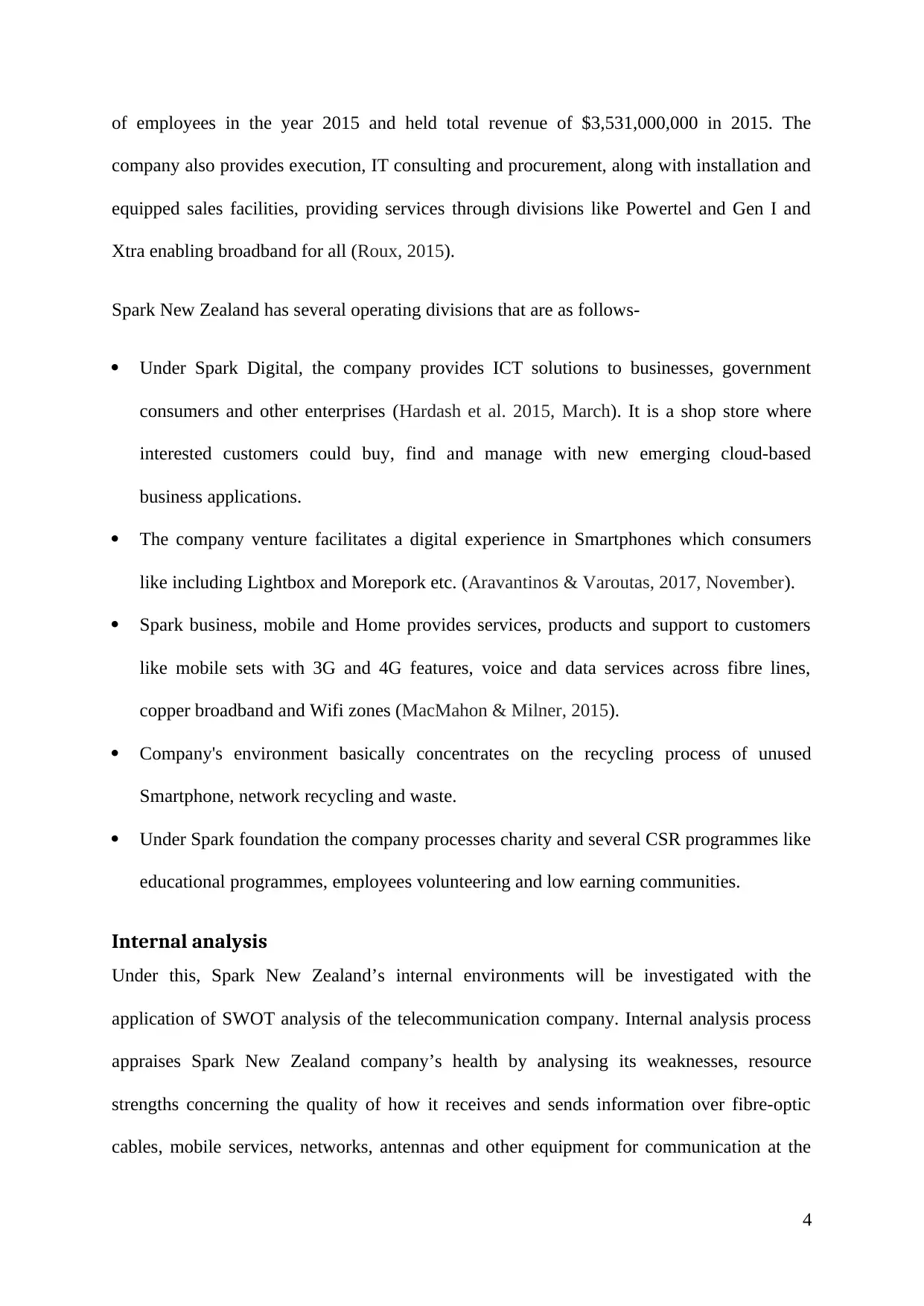
of employees in the year 2015 and held total revenue of $3,531,000,000 in 2015. The
company also provides execution, IT consulting and procurement, along with installation and
equipped sales facilities, providing services through divisions like Powertel and Gen I and
Xtra enabling broadband for all (Roux, 2015).
Spark New Zealand has several operating divisions that are as follows-
Under Spark Digital, the company provides ICT solutions to businesses, government
consumers and other enterprises (Hardash et al. 2015, March). It is a shop store where
interested customers could buy, find and manage with new emerging cloud-based
business applications.
The company venture facilitates a digital experience in Smartphones which consumers
like including Lightbox and Morepork etc. (Aravantinos & Varoutas, 2017, November).
Spark business, mobile and Home provides services, products and support to customers
like mobile sets with 3G and 4G features, voice and data services across fibre lines,
copper broadband and Wifi zones (MacMahon & Milner, 2015).
Company's environment basically concentrates on the recycling process of unused
Smartphone, network recycling and waste.
Under Spark foundation the company processes charity and several CSR programmes like
educational programmes, employees volunteering and low earning communities.
Internal analysis
Under this, Spark New Zealand’s internal environments will be investigated with the
application of SWOT analysis of the telecommunication company. Internal analysis process
appraises Spark New Zealand company’s health by analysing its weaknesses, resource
strengths concerning the quality of how it receives and sends information over fibre-optic
cables, mobile services, networks, antennas and other equipment for communication at the
4
company also provides execution, IT consulting and procurement, along with installation and
equipped sales facilities, providing services through divisions like Powertel and Gen I and
Xtra enabling broadband for all (Roux, 2015).
Spark New Zealand has several operating divisions that are as follows-
Under Spark Digital, the company provides ICT solutions to businesses, government
consumers and other enterprises (Hardash et al. 2015, March). It is a shop store where
interested customers could buy, find and manage with new emerging cloud-based
business applications.
The company venture facilitates a digital experience in Smartphones which consumers
like including Lightbox and Morepork etc. (Aravantinos & Varoutas, 2017, November).
Spark business, mobile and Home provides services, products and support to customers
like mobile sets with 3G and 4G features, voice and data services across fibre lines,
copper broadband and Wifi zones (MacMahon & Milner, 2015).
Company's environment basically concentrates on the recycling process of unused
Smartphone, network recycling and waste.
Under Spark foundation the company processes charity and several CSR programmes like
educational programmes, employees volunteering and low earning communities.
Internal analysis
Under this, Spark New Zealand’s internal environments will be investigated with the
application of SWOT analysis of the telecommunication company. Internal analysis process
appraises Spark New Zealand company’s health by analysing its weaknesses, resource
strengths concerning the quality of how it receives and sends information over fibre-optic
cables, mobile services, networks, antennas and other equipment for communication at the
4
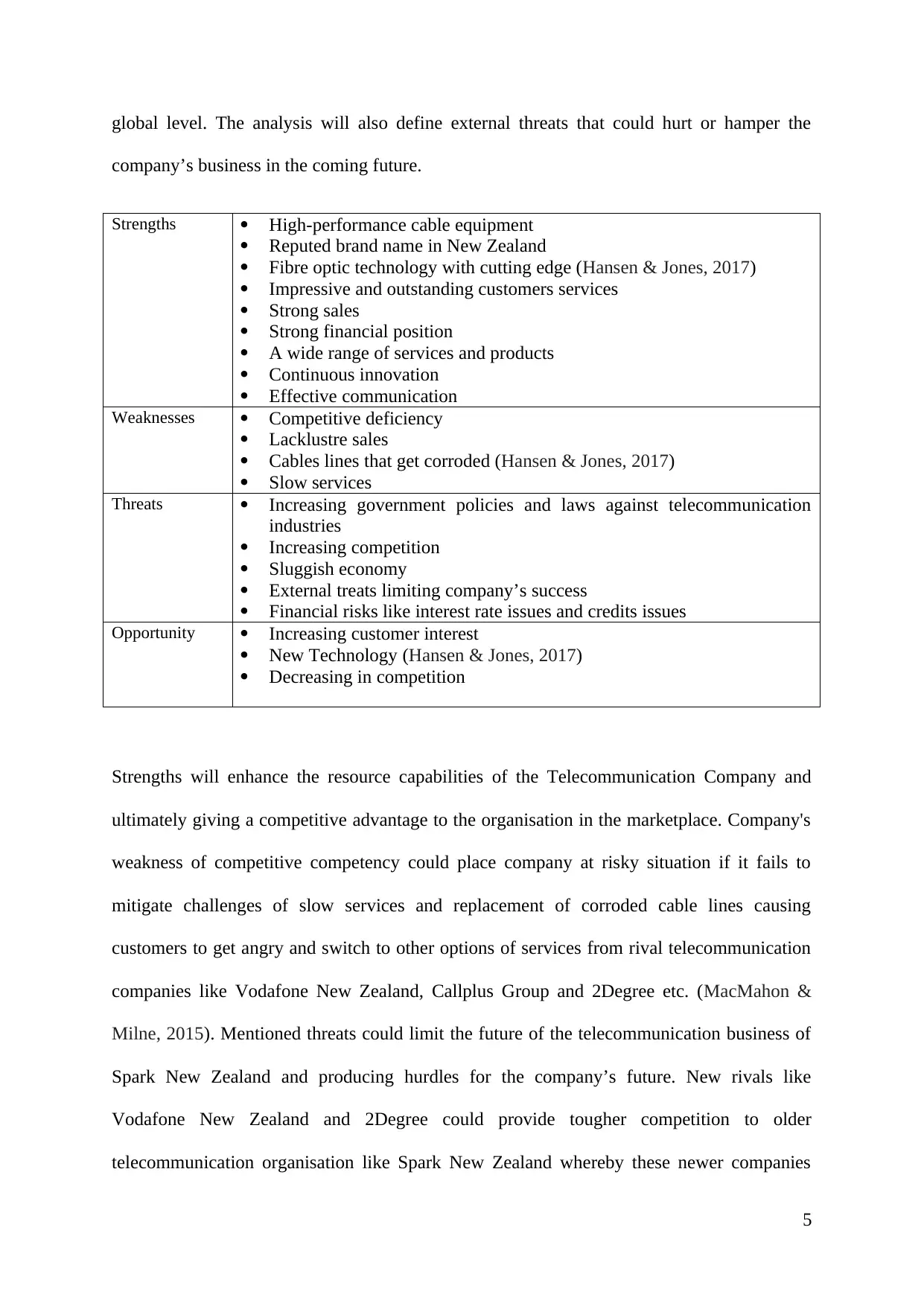
global level. The analysis will also define external threats that could hurt or hamper the
company’s business in the coming future.
Strengths High-performance cable equipment
Reputed brand name in New Zealand
Fibre optic technology with cutting edge (Hansen & Jones, 2017)
Impressive and outstanding customers services
Strong sales
Strong financial position
A wide range of services and products
Continuous innovation
Effective communication
Weaknesses Competitive deficiency
Lacklustre sales
Cables lines that get corroded (Hansen & Jones, 2017)
Slow services
Threats Increasing government policies and laws against telecommunication
industries
Increasing competition
Sluggish economy
External treats limiting company’s success
Financial risks like interest rate issues and credits issues
Opportunity Increasing customer interest
New Technology (Hansen & Jones, 2017)
Decreasing in competition
Strengths will enhance the resource capabilities of the Telecommunication Company and
ultimately giving a competitive advantage to the organisation in the marketplace. Company's
weakness of competitive competency could place company at risky situation if it fails to
mitigate challenges of slow services and replacement of corroded cable lines causing
customers to get angry and switch to other options of services from rival telecommunication
companies like Vodafone New Zealand, Callplus Group and 2Degree etc. (MacMahon &
Milne, 2015). Mentioned threats could limit the future of the telecommunication business of
Spark New Zealand and producing hurdles for the company’s future. New rivals like
Vodafone New Zealand and 2Degree could provide tougher competition to older
telecommunication organisation like Spark New Zealand whereby these newer companies
5
company’s business in the coming future.
Strengths High-performance cable equipment
Reputed brand name in New Zealand
Fibre optic technology with cutting edge (Hansen & Jones, 2017)
Impressive and outstanding customers services
Strong sales
Strong financial position
A wide range of services and products
Continuous innovation
Effective communication
Weaknesses Competitive deficiency
Lacklustre sales
Cables lines that get corroded (Hansen & Jones, 2017)
Slow services
Threats Increasing government policies and laws against telecommunication
industries
Increasing competition
Sluggish economy
External treats limiting company’s success
Financial risks like interest rate issues and credits issues
Opportunity Increasing customer interest
New Technology (Hansen & Jones, 2017)
Decreasing in competition
Strengths will enhance the resource capabilities of the Telecommunication Company and
ultimately giving a competitive advantage to the organisation in the marketplace. Company's
weakness of competitive competency could place company at risky situation if it fails to
mitigate challenges of slow services and replacement of corroded cable lines causing
customers to get angry and switch to other options of services from rival telecommunication
companies like Vodafone New Zealand, Callplus Group and 2Degree etc. (MacMahon &
Milne, 2015). Mentioned threats could limit the future of the telecommunication business of
Spark New Zealand and producing hurdles for the company’s future. New rivals like
Vodafone New Zealand and 2Degree could provide tougher competition to older
telecommunication organisation like Spark New Zealand whereby these newer companies
5
⊘ This is a preview!⊘
Do you want full access?
Subscribe today to unlock all pages.

Trusted by 1+ million students worldwide
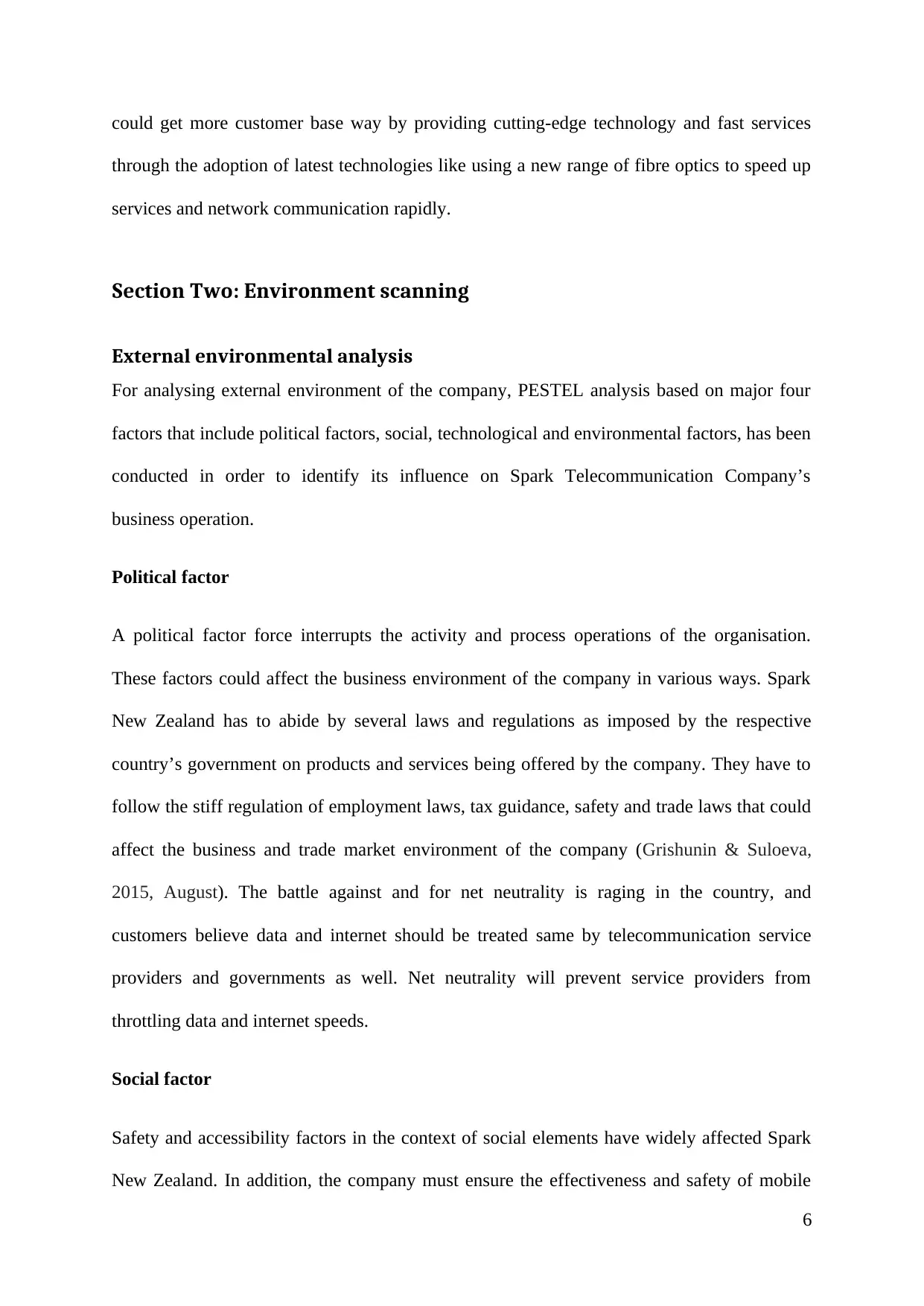
could get more customer base way by providing cutting-edge technology and fast services
through the adoption of latest technologies like using a new range of fibre optics to speed up
services and network communication rapidly.
Section Two: Environment scanning
External environmental analysis
For analysing external environment of the company, PESTEL analysis based on major four
factors that include political factors, social, technological and environmental factors, has been
conducted in order to identify its influence on Spark Telecommunication Company’s
business operation.
Political factor
A political factor force interrupts the activity and process operations of the organisation.
These factors could affect the business environment of the company in various ways. Spark
New Zealand has to abide by several laws and regulations as imposed by the respective
country’s government on products and services being offered by the company. They have to
follow the stiff regulation of employment laws, tax guidance, safety and trade laws that could
affect the business and trade market environment of the company (Grishunin & Suloeva,
2015, August). The battle against and for net neutrality is raging in the country, and
customers believe data and internet should be treated same by telecommunication service
providers and governments as well. Net neutrality will prevent service providers from
throttling data and internet speeds.
Social factor
Safety and accessibility factors in the context of social elements have widely affected Spark
New Zealand. In addition, the company must ensure the effectiveness and safety of mobile
6
through the adoption of latest technologies like using a new range of fibre optics to speed up
services and network communication rapidly.
Section Two: Environment scanning
External environmental analysis
For analysing external environment of the company, PESTEL analysis based on major four
factors that include political factors, social, technological and environmental factors, has been
conducted in order to identify its influence on Spark Telecommunication Company’s
business operation.
Political factor
A political factor force interrupts the activity and process operations of the organisation.
These factors could affect the business environment of the company in various ways. Spark
New Zealand has to abide by several laws and regulations as imposed by the respective
country’s government on products and services being offered by the company. They have to
follow the stiff regulation of employment laws, tax guidance, safety and trade laws that could
affect the business and trade market environment of the company (Grishunin & Suloeva,
2015, August). The battle against and for net neutrality is raging in the country, and
customers believe data and internet should be treated same by telecommunication service
providers and governments as well. Net neutrality will prevent service providers from
throttling data and internet speeds.
Social factor
Safety and accessibility factors in the context of social elements have widely affected Spark
New Zealand. In addition, the company must ensure the effectiveness and safety of mobile
6
Paraphrase This Document
Need a fresh take? Get an instant paraphrase of this document with our AI Paraphraser
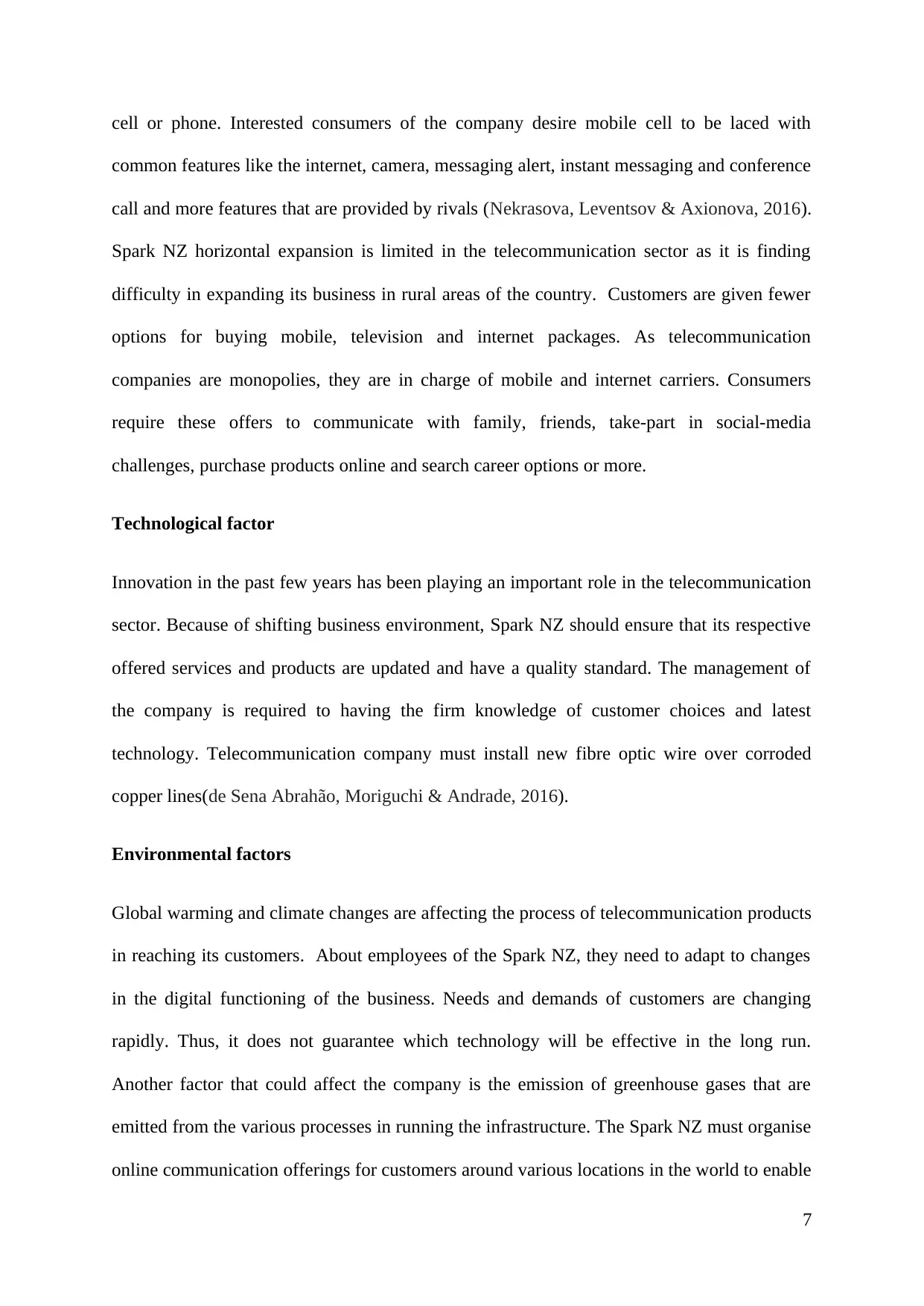
cell or phone. Interested consumers of the company desire mobile cell to be laced with
common features like the internet, camera, messaging alert, instant messaging and conference
call and more features that are provided by rivals (Nekrasova, Leventsov & Axionova, 2016).
Spark NZ horizontal expansion is limited in the telecommunication sector as it is finding
difficulty in expanding its business in rural areas of the country. Customers are given fewer
options for buying mobile, television and internet packages. As telecommunication
companies are monopolies, they are in charge of mobile and internet carriers. Consumers
require these offers to communicate with family, friends, take-part in social-media
challenges, purchase products online and search career options or more.
Technological factor
Innovation in the past few years has been playing an important role in the telecommunication
sector. Because of shifting business environment, Spark NZ should ensure that its respective
offered services and products are updated and have a quality standard. The management of
the company is required to having the firm knowledge of customer choices and latest
technology. Telecommunication company must install new fibre optic wire over corroded
copper lines(de Sena Abrahão, Moriguchi & Andrade, 2016).
Environmental factors
Global warming and climate changes are affecting the process of telecommunication products
in reaching its customers. About employees of the Spark NZ, they need to adapt to changes
in the digital functioning of the business. Needs and demands of customers are changing
rapidly. Thus, it does not guarantee which technology will be effective in the long run.
Another factor that could affect the company is the emission of greenhouse gases that are
emitted from the various processes in running the infrastructure. The Spark NZ must organise
online communication offerings for customers around various locations in the world to enable
7
common features like the internet, camera, messaging alert, instant messaging and conference
call and more features that are provided by rivals (Nekrasova, Leventsov & Axionova, 2016).
Spark NZ horizontal expansion is limited in the telecommunication sector as it is finding
difficulty in expanding its business in rural areas of the country. Customers are given fewer
options for buying mobile, television and internet packages. As telecommunication
companies are monopolies, they are in charge of mobile and internet carriers. Consumers
require these offers to communicate with family, friends, take-part in social-media
challenges, purchase products online and search career options or more.
Technological factor
Innovation in the past few years has been playing an important role in the telecommunication
sector. Because of shifting business environment, Spark NZ should ensure that its respective
offered services and products are updated and have a quality standard. The management of
the company is required to having the firm knowledge of customer choices and latest
technology. Telecommunication company must install new fibre optic wire over corroded
copper lines(de Sena Abrahão, Moriguchi & Andrade, 2016).
Environmental factors
Global warming and climate changes are affecting the process of telecommunication products
in reaching its customers. About employees of the Spark NZ, they need to adapt to changes
in the digital functioning of the business. Needs and demands of customers are changing
rapidly. Thus, it does not guarantee which technology will be effective in the long run.
Another factor that could affect the company is the emission of greenhouse gases that are
emitted from the various processes in running the infrastructure. The Spark NZ must organise
online communication offerings for customers around various locations in the world to enable
7
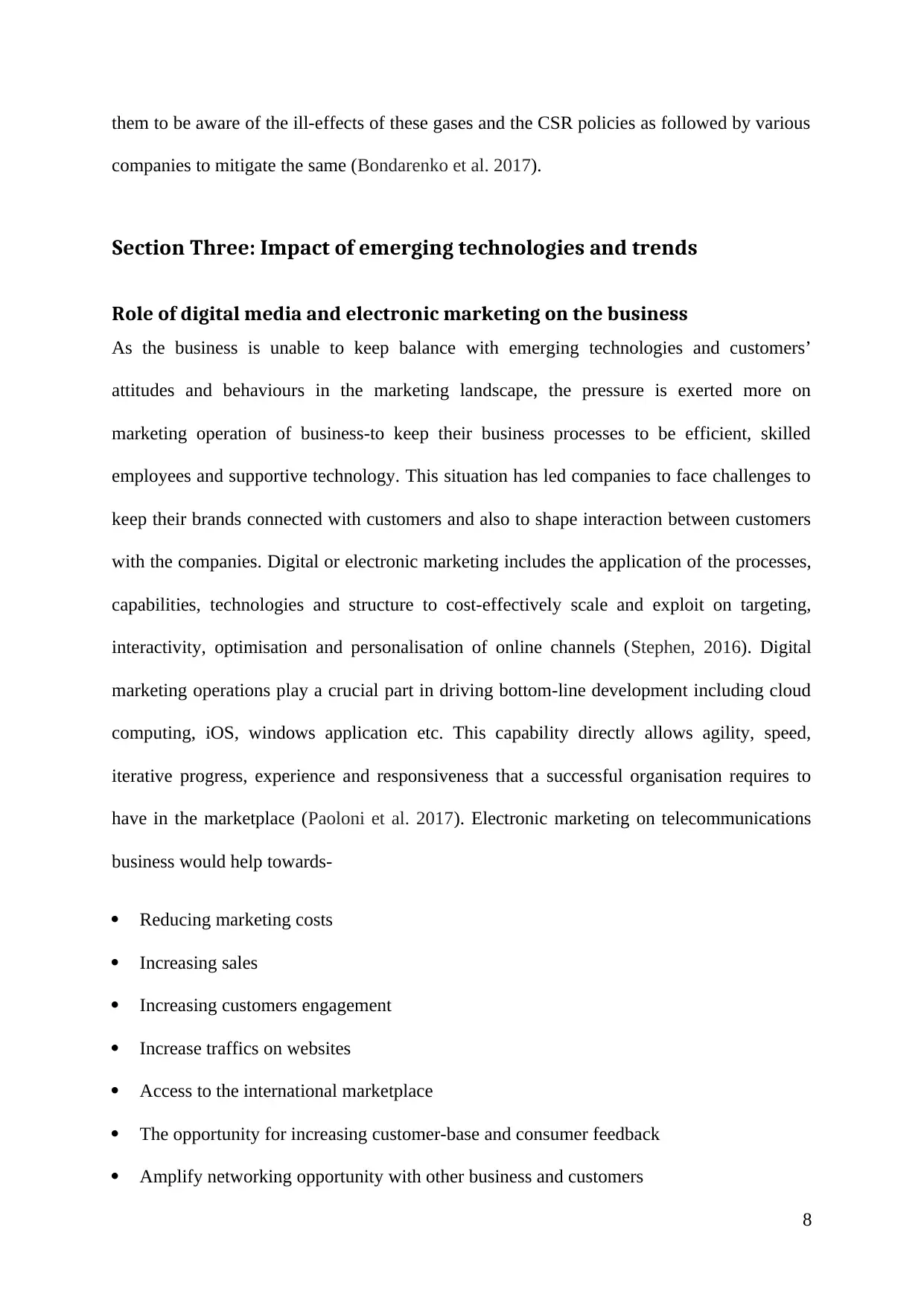
them to be aware of the ill-effects of these gases and the CSR policies as followed by various
companies to mitigate the same (Bondarenko et al. 2017).
Section Three: Impact of emerging technologies and trends
Role of digital media and electronic marketing on the business
As the business is unable to keep balance with emerging technologies and customers’
attitudes and behaviours in the marketing landscape, the pressure is exerted more on
marketing operation of business-to keep their business processes to be efficient, skilled
employees and supportive technology. This situation has led companies to face challenges to
keep their brands connected with customers and also to shape interaction between customers
with the companies. Digital or electronic marketing includes the application of the processes,
capabilities, technologies and structure to cost-effectively scale and exploit on targeting,
interactivity, optimisation and personalisation of online channels (Stephen, 2016). Digital
marketing operations play a crucial part in driving bottom-line development including cloud
computing, iOS, windows application etc. This capability directly allows agility, speed,
iterative progress, experience and responsiveness that a successful organisation requires to
have in the marketplace (Paoloni et al. 2017). Electronic marketing on telecommunications
business would help towards-
Reducing marketing costs
Increasing sales
Increasing customers engagement
Increase traffics on websites
Access to the international marketplace
The opportunity for increasing customer-base and consumer feedback
Amplify networking opportunity with other business and customers
8
companies to mitigate the same (Bondarenko et al. 2017).
Section Three: Impact of emerging technologies and trends
Role of digital media and electronic marketing on the business
As the business is unable to keep balance with emerging technologies and customers’
attitudes and behaviours in the marketing landscape, the pressure is exerted more on
marketing operation of business-to keep their business processes to be efficient, skilled
employees and supportive technology. This situation has led companies to face challenges to
keep their brands connected with customers and also to shape interaction between customers
with the companies. Digital or electronic marketing includes the application of the processes,
capabilities, technologies and structure to cost-effectively scale and exploit on targeting,
interactivity, optimisation and personalisation of online channels (Stephen, 2016). Digital
marketing operations play a crucial part in driving bottom-line development including cloud
computing, iOS, windows application etc. This capability directly allows agility, speed,
iterative progress, experience and responsiveness that a successful organisation requires to
have in the marketplace (Paoloni et al. 2017). Electronic marketing on telecommunications
business would help towards-
Reducing marketing costs
Increasing sales
Increasing customers engagement
Increase traffics on websites
Access to the international marketplace
The opportunity for increasing customer-base and consumer feedback
Amplify networking opportunity with other business and customers
8
⊘ This is a preview!⊘
Do you want full access?
Subscribe today to unlock all pages.

Trusted by 1+ million students worldwide
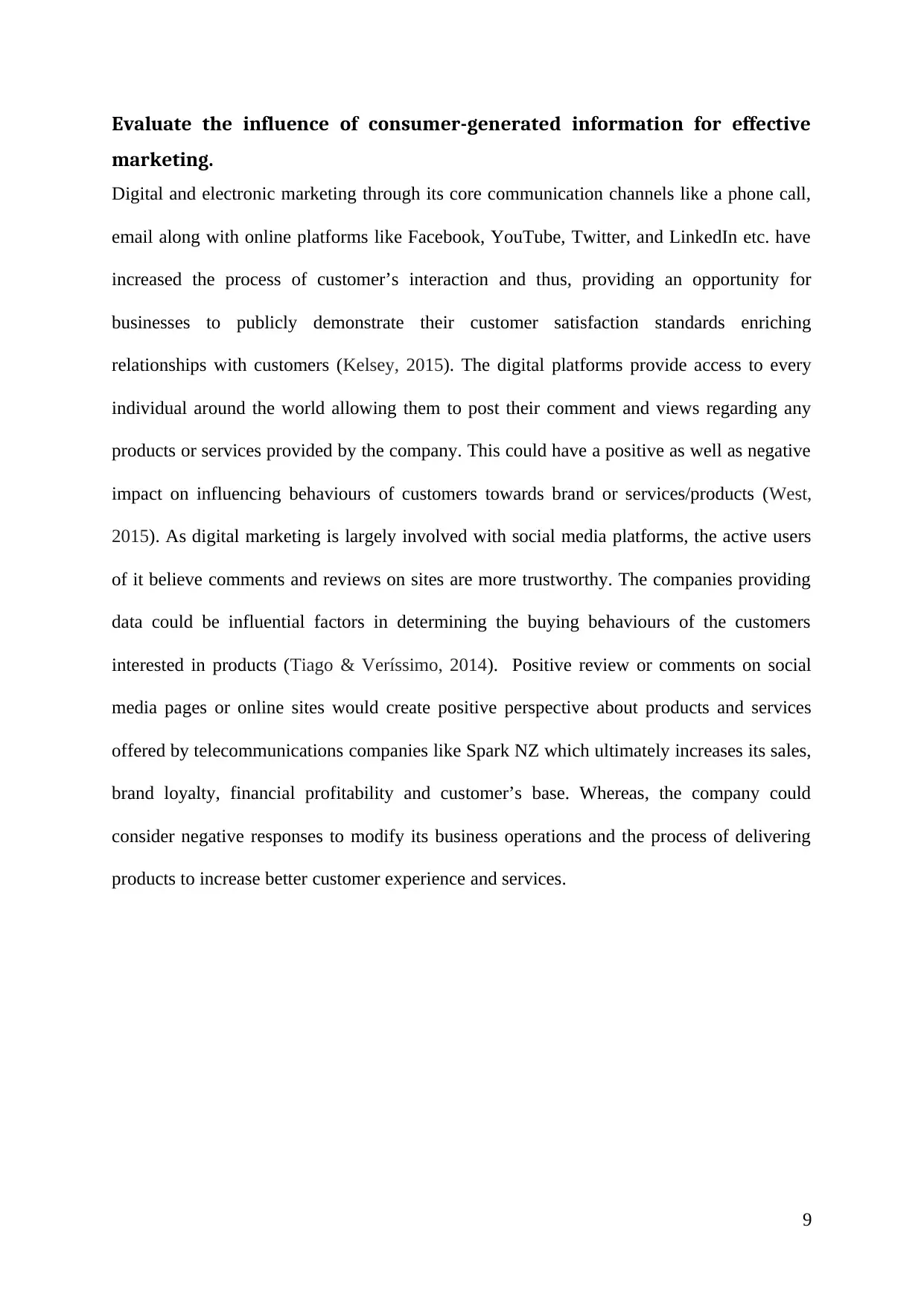
Evaluate the influence of consumer-generated information for effective
marketing.
Digital and electronic marketing through its core communication channels like a phone call,
email along with online platforms like Facebook, YouTube, Twitter, and LinkedIn etc. have
increased the process of customer’s interaction and thus, providing an opportunity for
businesses to publicly demonstrate their customer satisfaction standards enriching
relationships with customers (Kelsey, 2015). The digital platforms provide access to every
individual around the world allowing them to post their comment and views regarding any
products or services provided by the company. This could have a positive as well as negative
impact on influencing behaviours of customers towards brand or services/products (West,
2015). As digital marketing is largely involved with social media platforms, the active users
of it believe comments and reviews on sites are more trustworthy. The companies providing
data could be influential factors in determining the buying behaviours of the customers
interested in products (Tiago & Veríssimo, 2014). Positive review or comments on social
media pages or online sites would create positive perspective about products and services
offered by telecommunications companies like Spark NZ which ultimately increases its sales,
brand loyalty, financial profitability and customer’s base. Whereas, the company could
consider negative responses to modify its business operations and the process of delivering
products to increase better customer experience and services.
9
marketing.
Digital and electronic marketing through its core communication channels like a phone call,
email along with online platforms like Facebook, YouTube, Twitter, and LinkedIn etc. have
increased the process of customer’s interaction and thus, providing an opportunity for
businesses to publicly demonstrate their customer satisfaction standards enriching
relationships with customers (Kelsey, 2015). The digital platforms provide access to every
individual around the world allowing them to post their comment and views regarding any
products or services provided by the company. This could have a positive as well as negative
impact on influencing behaviours of customers towards brand or services/products (West,
2015). As digital marketing is largely involved with social media platforms, the active users
of it believe comments and reviews on sites are more trustworthy. The companies providing
data could be influential factors in determining the buying behaviours of the customers
interested in products (Tiago & Veríssimo, 2014). Positive review or comments on social
media pages or online sites would create positive perspective about products and services
offered by telecommunications companies like Spark NZ which ultimately increases its sales,
brand loyalty, financial profitability and customer’s base. Whereas, the company could
consider negative responses to modify its business operations and the process of delivering
products to increase better customer experience and services.
9
Paraphrase This Document
Need a fresh take? Get an instant paraphrase of this document with our AI Paraphraser
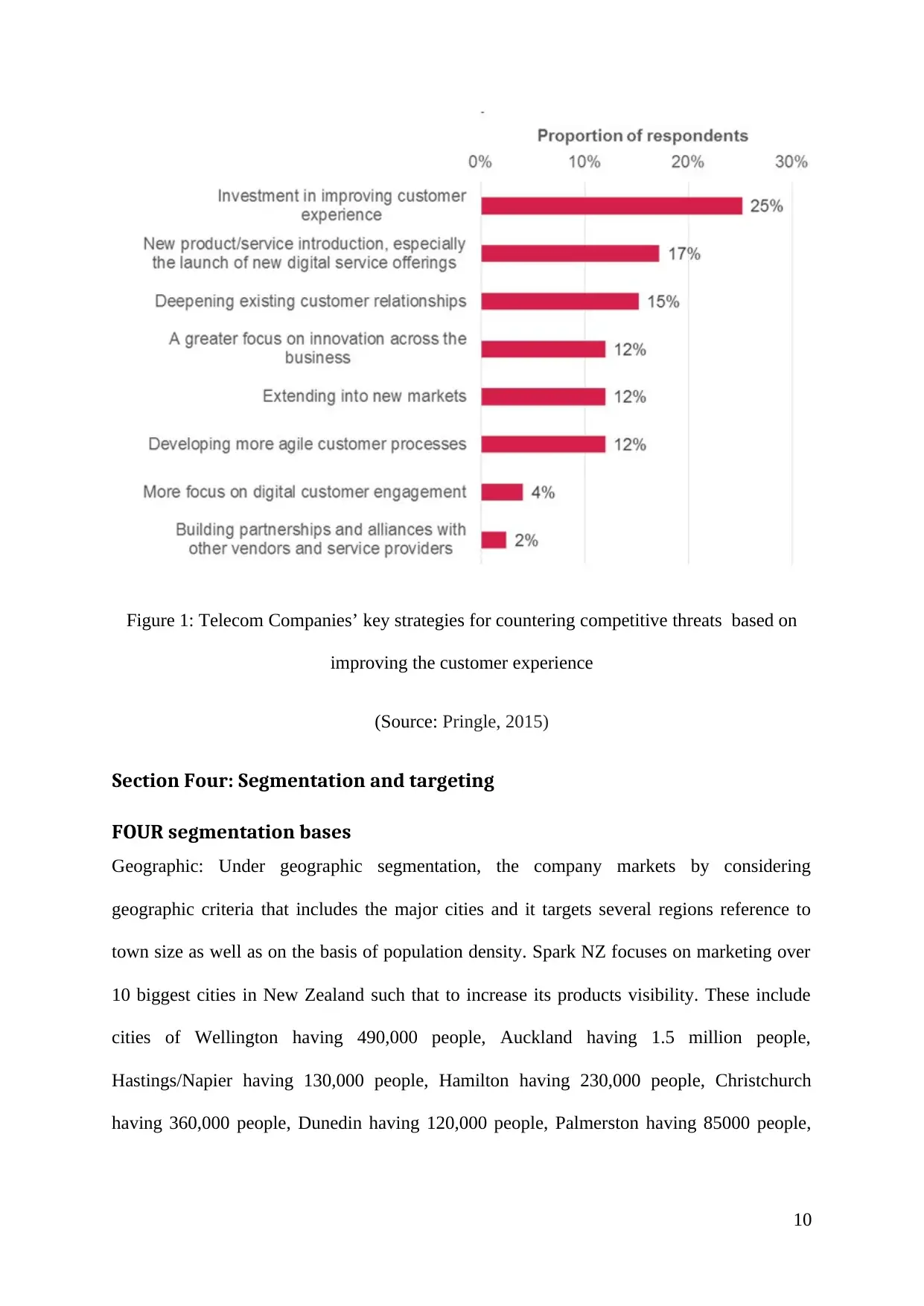
Figure 1: Telecom Companies’ key strategies for countering competitive threats based on
improving the customer experience
(Source: Pringle, 2015)
Section Four: Segmentation and targeting
FOUR segmentation bases
Geographic: Under geographic segmentation, the company markets by considering
geographic criteria that includes the major cities and it targets several regions reference to
town size as well as on the basis of population density. Spark NZ focuses on marketing over
10 biggest cities in New Zealand such that to increase its products visibility. These include
cities of Wellington having 490,000 people, Auckland having 1.5 million people,
Hastings/Napier having 130,000 people, Hamilton having 230,000 people, Christchurch
having 360,000 people, Dunedin having 120,000 people, Palmerston having 85000 people,
10
improving the customer experience
(Source: Pringle, 2015)
Section Four: Segmentation and targeting
FOUR segmentation bases
Geographic: Under geographic segmentation, the company markets by considering
geographic criteria that includes the major cities and it targets several regions reference to
town size as well as on the basis of population density. Spark NZ focuses on marketing over
10 biggest cities in New Zealand such that to increase its products visibility. These include
cities of Wellington having 490,000 people, Auckland having 1.5 million people,
Hastings/Napier having 130,000 people, Hamilton having 230,000 people, Christchurch
having 360,000 people, Dunedin having 120,000 people, Palmerston having 85000 people,
10
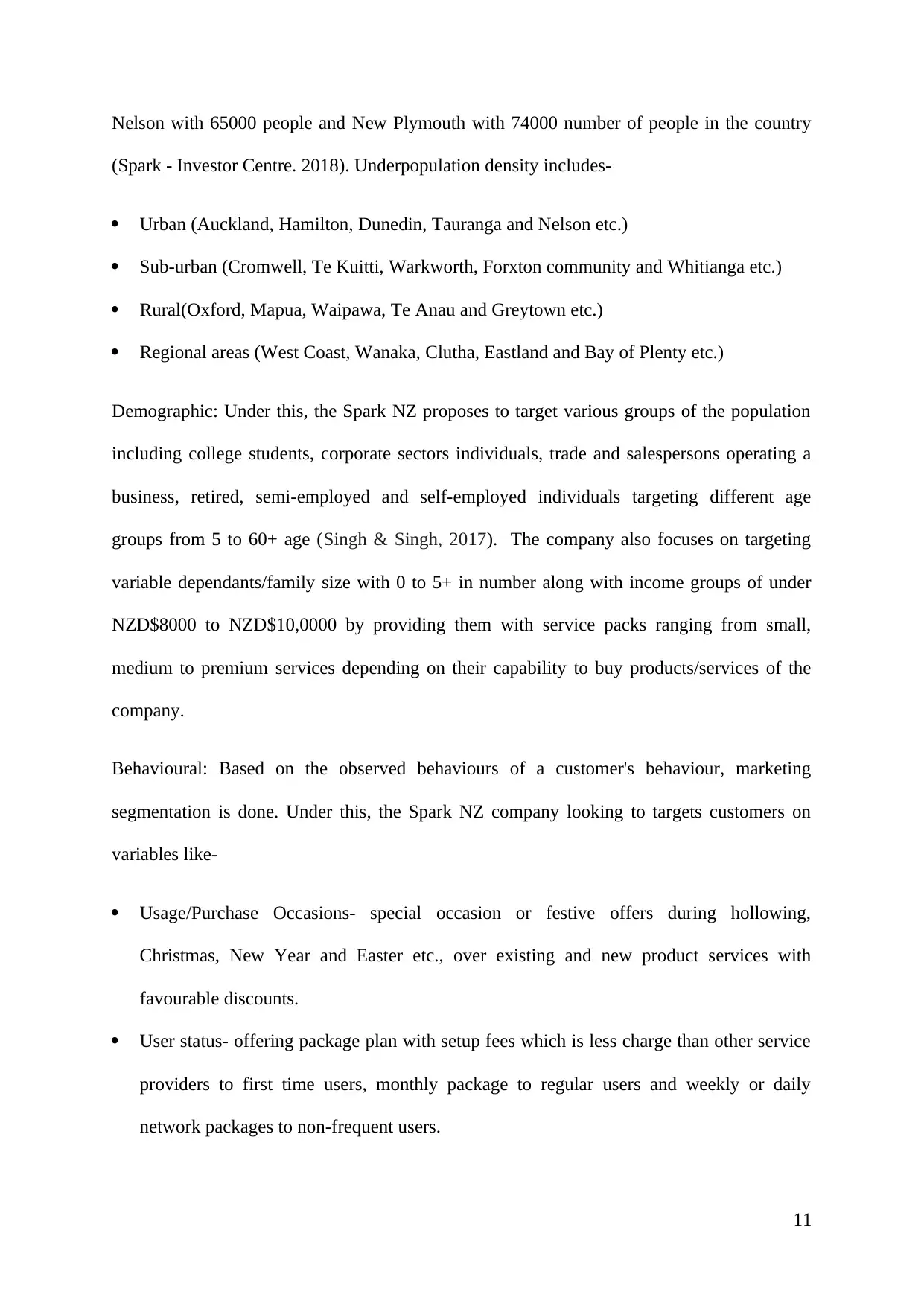
Nelson with 65000 people and New Plymouth with 74000 number of people in the country
(Spark - Investor Centre. 2018). Underpopulation density includes-
Urban (Auckland, Hamilton, Dunedin, Tauranga and Nelson etc.)
Sub-urban (Cromwell, Te Kuitti, Warkworth, Forxton community and Whitianga etc.)
Rural(Oxford, Mapua, Waipawa, Te Anau and Greytown etc.)
Regional areas (West Coast, Wanaka, Clutha, Eastland and Bay of Plenty etc.)
Demographic: Under this, the Spark NZ proposes to target various groups of the population
including college students, corporate sectors individuals, trade and salespersons operating a
business, retired, semi-employed and self-employed individuals targeting different age
groups from 5 to 60+ age (Singh & Singh, 2017). The company also focuses on targeting
variable dependants/family size with 0 to 5+ in number along with income groups of under
NZD$8000 to NZD$10,0000 by providing them with service packs ranging from small,
medium to premium services depending on their capability to buy products/services of the
company.
Behavioural: Based on the observed behaviours of a customer's behaviour, marketing
segmentation is done. Under this, the Spark NZ company looking to targets customers on
variables like-
Usage/Purchase Occasions- special occasion or festive offers during hollowing,
Christmas, New Year and Easter etc., over existing and new product services with
favourable discounts.
User status- offering package plan with setup fees which is less charge than other service
providers to first time users, monthly package to regular users and weekly or daily
network packages to non-frequent users.
11
(Spark - Investor Centre. 2018). Underpopulation density includes-
Urban (Auckland, Hamilton, Dunedin, Tauranga and Nelson etc.)
Sub-urban (Cromwell, Te Kuitti, Warkworth, Forxton community and Whitianga etc.)
Rural(Oxford, Mapua, Waipawa, Te Anau and Greytown etc.)
Regional areas (West Coast, Wanaka, Clutha, Eastland and Bay of Plenty etc.)
Demographic: Under this, the Spark NZ proposes to target various groups of the population
including college students, corporate sectors individuals, trade and salespersons operating a
business, retired, semi-employed and self-employed individuals targeting different age
groups from 5 to 60+ age (Singh & Singh, 2017). The company also focuses on targeting
variable dependants/family size with 0 to 5+ in number along with income groups of under
NZD$8000 to NZD$10,0000 by providing them with service packs ranging from small,
medium to premium services depending on their capability to buy products/services of the
company.
Behavioural: Based on the observed behaviours of a customer's behaviour, marketing
segmentation is done. Under this, the Spark NZ company looking to targets customers on
variables like-
Usage/Purchase Occasions- special occasion or festive offers during hollowing,
Christmas, New Year and Easter etc., over existing and new product services with
favourable discounts.
User status- offering package plan with setup fees which is less charge than other service
providers to first time users, monthly package to regular users and weekly or daily
network packages to non-frequent users.
11
⊘ This is a preview!⊘
Do you want full access?
Subscribe today to unlock all pages.

Trusted by 1+ million students worldwide
1 out of 18
Related Documents
Your All-in-One AI-Powered Toolkit for Academic Success.
+13062052269
info@desklib.com
Available 24*7 on WhatsApp / Email
![[object Object]](/_next/static/media/star-bottom.7253800d.svg)
Unlock your academic potential
Copyright © 2020–2025 A2Z Services. All Rights Reserved. Developed and managed by ZUCOL.





